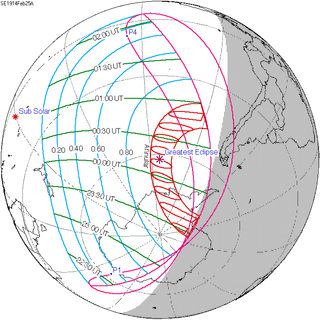| Solar eclipse of February 25, 1914 | |
|---|---|
| Type of eclipse | |
| Nature | Annular |
| Gamma | −0.9416 |
| Magnitude | 0.9248 |
| Maximum eclipse | |
| Duration | 335 s (5 min 35 s) |
| Coordinates | 62°06′S 113°18′W / 62.1°S 113.3°W |
| Max. width of band | 839 km (521 mi) |
| Times (UTC) | |
| Greatest eclipse | 0:13:01 |
| References | |
| Saros | 119 (60 of 71) |
| Catalog # (SE5000) | 9313 |
An annular solar eclipse occurred at the Moon's ascending node of orbit between Tuesday, February 24 and Wednesday, February 25, 1914,[1][2][3] with a magnitude of 0.9248. A solar eclipse occurs when the Moon passes between Earth and the Sun, thereby totally or partly obscuring the image of the Sun for a viewer on Earth. An annular solar eclipse occurs when the Moon's apparent diameter is smaller than the Sun's, blocking most of the Sun's light and causing the Sun to look like an annulus (ring). An annular eclipse appears as a partial eclipse over a region of the Earth thousands of kilometres wide. Occurring about 3.3 days before apogee (on February 28, 1914, at 9:10 UTC), the Moon's apparent diameter was smaller.[4]
It took place almost entirely over the Southern Ocean, near Antarctica;[2] at its widest, the shadow cast by the moon was 167 mi (269 km) wide.[2] As a result, it could be seen from small patches of land, most notably southern Patagonia and part of New Zealand.[2][3][5] Due to this limited visibility, the Star-Gazette of Elmira said that for readers in the United States it was "not particularly interesting from a popular perspective";[6] the Salina Daily Union in Salina, Kansas said that "you perhaps didn't notice it".[7] It was the first of four eclipses that occurred during the year 1914.[3][5] While its path passed over New Zealand, and some attempted to view it in Wellington, it was reported to not have been visible there due to cloud cover.[8][9]
- ^ "February 24–25, 1914 Annular Solar Eclipse". timeanddate. Retrieved 31 July 2024.
- ^ a b c d Cite error: The named reference
Washin19140226p4was invoked but never defined (see the help page). - ^ a b c Cite error: The named reference
ButteD19140223p12was invoked but never defined (see the help page). - ^ "Moon Distances for London, United Kingdom, England". timeanddate. Retrieved 31 July 2024.
- ^ a b Cite error: The named reference
Missou19140225p6was invoked but never defined (see the help page). - ^ Cite error: The named reference
StarGa19140223p2was invoked but never defined (see the help page). - ^ Cite error: The named reference
Salina19140225p1was invoked but never defined (see the help page). - ^ Cite error: The named reference
Sydney19140226p9was invoked but never defined (see the help page). - ^ Cite error: The named reference
DailyT19140226p9was invoked but never defined (see the help page).
